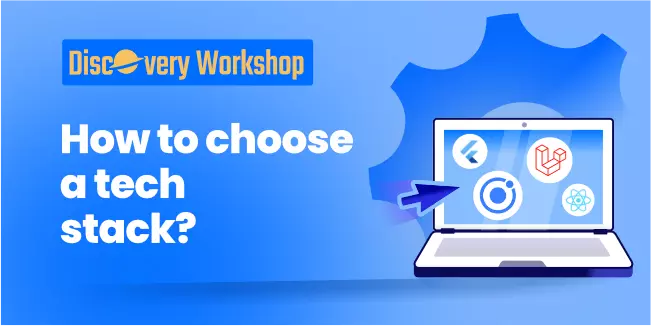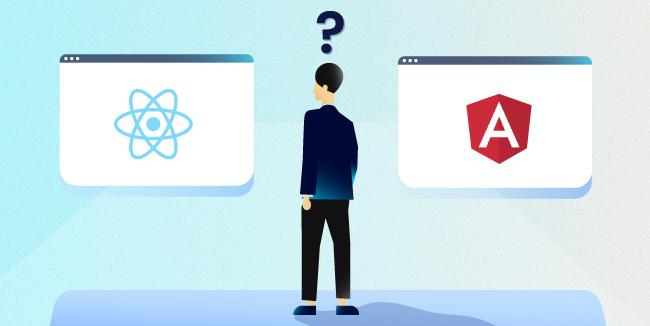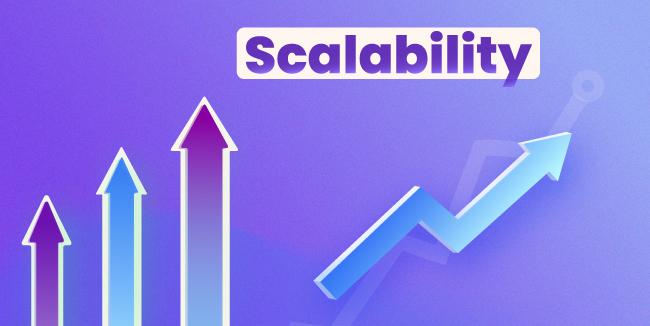choosetechstack
project
techstack
discoveryworkshop
How to choose a tech stack for your project?

Choosing a tech stack is a huge challenge, even for specialists. The most important thing is that the technology stack should be matched to the requirements of your software development project and not the other way around.
As the best product development company, we have prepared a series of articles about Discovery Workshop especially for you, to introduce you to the secrets of mobile app development. This workshop aims to analyze your app idea thoroughly, determine the exact stages of development and find solutions that will make the work result in a great product within the set budget and within the specified time.
Since the tech stack is crucial to the entire project, ask for advice from a trusted software development partner who has a rich company tech stack and will be able to advise you on the best solution. In the article "Choosing the right software partner - guide (2022)", you will find some tips that will make this task easier for you.
Choosing a tech stack is very important, and we have prepared the article below, where you will find all the critical issues regarding this topic.
Why is your tech stack important?
Your tech stack will determine the sort of app you'll be able to develop. It also has an impact on the kind of engineers you recruit. Developers specialize in specific technologies since there are too many to learn. Some technology stacks are better than others. Some, for example, are far more customizable. Others are more scalable. Some are superior to large-scale initiatives.
Talk to your lead engineer or CTO about your requirements before deciding on the solutions you'll use. The ideal solution is to hold a discovery workshop in which you, the team, and an expert will discuss the project, which will help you choose the right tech stack for your web app or mobile app.
While it is not impossible to modify your stack mid-project, it is a difficult task. That's why picking a technology stack before you begin any significant development on your digital product is critical.
What to consider when choosing a tech stack?
This section will discuss the most critical issues that affect the choice of technology, regardless of whether they are web or mobile applications. We talked about the tech stack itself, how we divide it, what it is, and the most popular tech stacks in other articles.
To anticipate what, why, and how to create, development must start with thoroughly preparing the fundamentals. We provide you with an unbiased assessment of the best technology stack for your IT project in our Discovery Workshop. Because you have access to the knowledge and expertise of our CTO and specialists, initiatives that begin with workshops are beneficial to your team and organization. It protects you from making mistakes while performing work. Remember that you don't have to create your product with us. You receive documentation from us, with which you can go to another custom software development company.
The sector your firm operates is one of the first things to consider when selecting a particular tech stack. It will not only be essential because of the type of products or services you provide but also owing of potential legal necessities and following established regulations.

Then comes your target audience. What do they enjoy? Do they depend on their phones so much that you should spend on a native mobile application? Where and how frequently will you need to communicate with them? These are all things you'll want to think about in order to reach your most valuable clients. We are talking about not only user interface and user experience, but also about Back-End. The infrastructure behind your app is made up of the technical stack, which includes back-end technologies. Back-end technology ensures that all features are responding to user requests correctly. Programming languages, server-side frameworks, operating systems, databases, and APIs are some of the components. The backend also contains business logic, hosting, operating systems, web servers, programming languages, frameworks, databases, and cloud infrastructure and services. On the other hand, the frontend is also known as the client-side, as users see and interact with this part of an app.
Third-party integrations are also essential. It's becoming more popular to have different systems working together to create a fantastic experience, but that doesn't mean you should overcomplicate things just for the sake of it when your needs are straightforward.
A headless/decoupled approach to managing digital experiences may be the best fit for businesses that engage across numerous platforms or operate in the IoT arena. A single site with a highly customized front end, such as microservices, might use the same method.
Type of project: The product specification and functionality
There is no such thing as a one-size-fits-all technology stack. Goods and services necessitate different development tools. Time-tested technologies might not be appropriate for your team's specific product or application, and new ones may not have all of the desired features or support. Selecting technology that will enhance the performance of your product or application should be your primary concern.
The technologies you'll need to use may be determined by the project you're working on. You can use PHP or Node.JS to create a Minimum Viable Product more quickly, for example, if you need to do so. Both of these languages assist with rapid development.
When it comes to web applications, you must first determine your target audience's needs, and the capabilities of your product must meet these issues to solve them. It makes sense to perform this step after or with market research to determine what existing goods and additional criteria your software needs to exceed the competition.
Project size
The size of your project has a significant influence on which technical architecture you should use. You can complete the most modest tasks with just a few technologies. A small project may require a different tech stack than a mid-sized or large one. It's worth noting when selecting a technology stack. Aside from size, the degree of difficulty in the job is also essential. The more complex the task is, the more extensive the programming language is required.

On the other hand, large projects frequently require more complicated stacks and specialized tools. You could need several packages for various elements, and your core framework should be able to handle a large number of users.
Cost
They claim that money makes the world go around. Besides, free things do not exist. On the contrary, several well-known open-source IT platforms and software are completely free. However, they come with a cost if you want certain or unique features. You may need to pay for licensing and upkeep expenses. All of these elements may influence your tech stack selection.
The tug of war occurs when deciding between the overall cost of utilizing a technology stack and its capabilities. Furthermore, some technology stacks need high-salary developers, so you must factor that in. If a feature is available, you may also have to look at the cost of teaching developers for a particular tech stack.
Stack costs vary depending on the host, third-party software, and other factors. Your expenses will differ based on:
- Hosting costs
- Developer salaries
- Technology licensing fees
- Maintenance costs
Your budget will generally determine which technological platform you can employ. More sophisticated and complex technologies are more expensive in general. It also costs more to run since you need someone on your team with specific knowledge.
Time to market
The speed you intend to launch will also influence your technology stack. Some technology stacks utilize reusable code snippets to assist reduce development time. If you want an app quickly, go with one of these options.
System load requirements
It's another vital component. Many projects have different processing demands, so not every technology stack can meet all required processing capabilities. So this is to say that you must examine your prospective product's processing loads against the technology stack's ability to fulfill those needs before deciding.
Scalability
Your development team has to think about the scalability of your product. The development process, which starts with the analysis, can meet that need when creating mobile or web apps.
A technology stack in scaling an application aims to provide a rise in users and capabilities. Your developers should select a tech stack that allows for introducing new exciting features, user growth, and seasonal increases in users. It is significant since technology does not stay the same. Technology is constantly evolving, upgrading, and adjusting daily. So you must first be aware of the current development trends for the next several years and determine whether it's worthwhile to hire someone for your project. It allows you to be sure that the technology stack you choose will enable your project to function effectively during every stage of change.

Vertical scaling, which is the layering of multiple application servers to handle user traffic flow, and horizontal scaling for the inclusion of extra applications to process new data types, must be included in your provision for scalability. You will be protected from your application crashing by scaling horizontally and vertically when adverse conditions arise.
Maintenance
It would help if you thought about how your team will keep the application running once it is launched. It is the next lane after you've created your app, and it's also related to your technology stack.
If you want a feasible tech stack to maintain, choose one based on software architecture and existing code. Consider picking languages suited for short, reusable, and easy-to-maintain programs. Your codebase should be straightforward and of modest size. It allows developers to spend a tiny amount of time attempting to examine, debug, and process the codes in their heads before committing them to source control.
In terms of distributed applications, your application's architecture is one of the essential technologies for allowing scaling, portability, and reuse. Even if users grow or you introduce more engaging features, the application's performance is uninterrupted. Your technological infrastructure should be based on your software architecture. Consider technologies that will enable static and dynamic component configurations based on this information.
Security
Some applications need a higher degree of security. Suppose you're creating a program that handles private financial data or medical history. In that case, security is more vital than a basic mobile game. You may need to fulfill licensing or regulatory standards in some cases.
Team expertise
Team expertise It all depends on how your developers can manage and employ the technology stack. What this implies is that you must evaluate your developers' skills. It will be a mismatch problem if they don't know how to operate the tech stack. It won't be too difficult since you'll outsource your project development.
Factors to put in place before considering which stack is best for your digital product
Let's look at a few factors that may impact your tech stack selection. If you've decided on a technology stack type, here are several questions to consider and check. They might help you save money on development and troubleshooting issues that may arise in the future. So, while selecting your web development technology stack, keep these things in mind:
- Defining your needs and assets.
- Make sure you don't duplicate what your competitors have done.
- Make an MVP and then test it.
- When it's feasible, utilize ready-made solutions.
- Begin by using a less complicated technology stack and remain nimble throughout the software development life cycle.
- In your thinking, be futuristic.
At mDevelopers, we have significant expertise in developing solutions for various industries using various technological stacks. As a result, you may engage our highly experienced team of professionals to bring your concepts, needs, and business demands to life.
Conclusion
When starting a new project, it is crucial to take the time to carefully choose your tech stack - the combination of software and hardware that will be used to build your product. It can be not easy, with many factors to consider, including cost, development speed, compatibility with existing solutions, and more mentioned above.

Luckily, there are tools and services available to help you make this decision more easily. One such tool is Discovery Workshops - specialized sessions designed to help you understand the technical feasibility of your idea, explore different technology options for your product, plan out its development roadmap, and save time and money in the long run.
So if you are looking for guidance in selecting a tech stack for your next project, make an appointment with our specialists for a free consultation. We have a wide portfolio of projects and love sharing our knowledge and experience.

This article is part of our Discovery Workshop series
What is Product Design? What is the Product Discovery and Product Discovery Process? Tips and Techniques for Effective Product Discovery Process Idea Validation in Practice Product Roadmap - how to write user stories and user flows? Now readingHow to choose a tech stack for your project? How to create a project timeline? How to create a project budget? Functional Requirements Document for your Product What is a Prototype? Build your MVP (Minimum Viable Product) the right way - step by step guide by mDevelopers